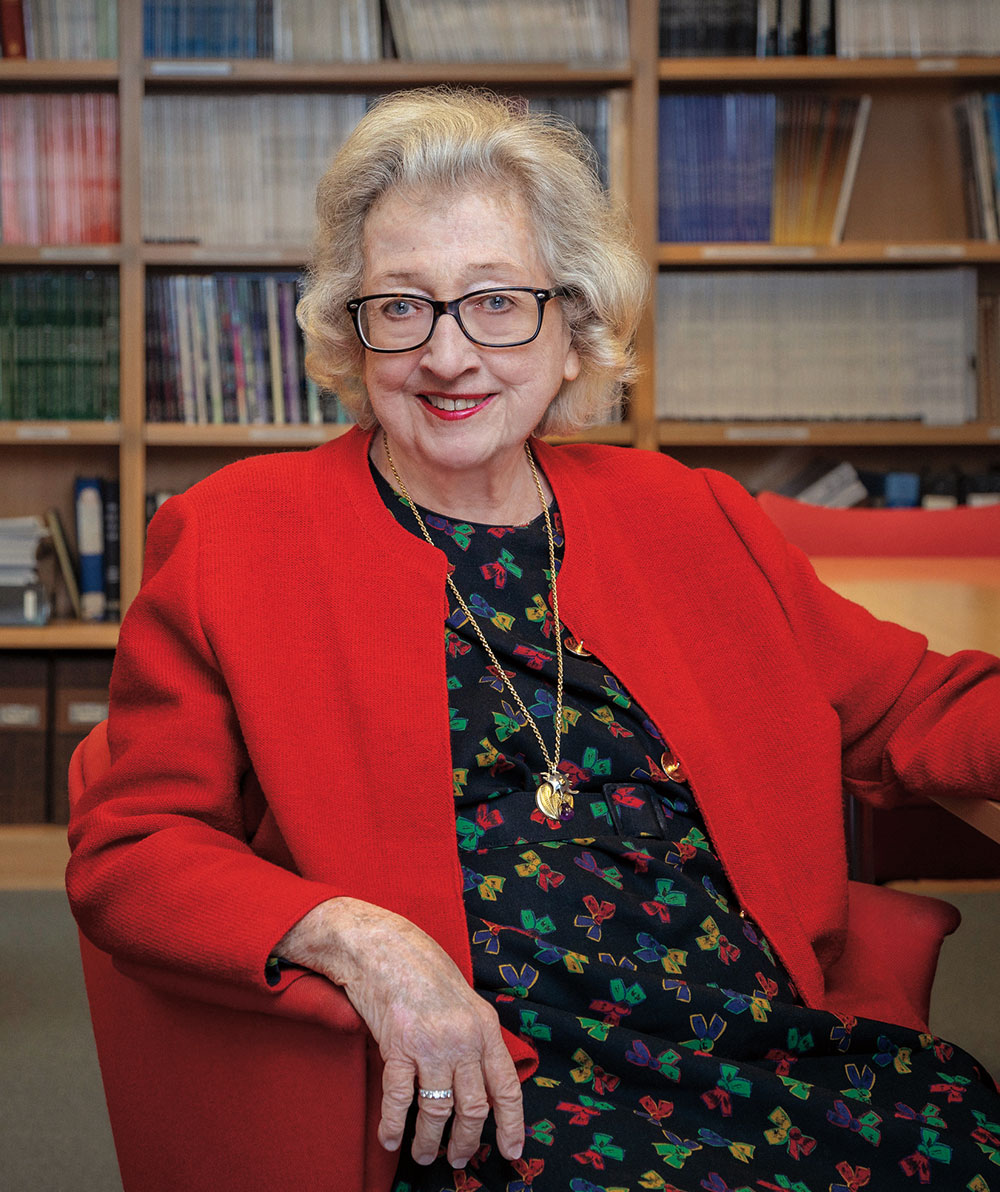
Interview
The long overdue science of addictions
With Mary Jeanne Kreek
By Bahar GholipourIt was called a trailblazing medical experiment but few scientists and physicians wanted to have anything to do with it. Launched in the early 1960s, it would have been illegal just a few years earlier, and the idea was still controversial.
Some of the patients, a group of men in their 20s and 30s, had already been in and out of jail a number of times. Once ordinary New Yorkers with respectable jobs—among them a musician, a truck driver, and an office clerk—they were now longtime heroin addicts, often dismissively labeled as “psychopaths” or “junkies.” The medical establishment believed their addiction lay beyond a doctor’s responsibility, and if they had been treated in a hospital before, they likely had been there as a prisoner.
At The Rockefeller University Hospital, however, the men found themselves in rooms with unlocked doors. There, every day for several months, Mary Jeanne Kreek, then a second year medical resident, gave them an oral dose of methadone—a special type of painkiller that Kreek and her mentors believed could treat the men’s addiction by stunting their hunger for heroin. And she cared for them with the bedside manners she would show any other patient.
“Addiction is less about seeking pleasure than about avoiding feeling ill.”
The experiment was among the very first to use a pharmaceutical intervention to treat addiction—and it worked. Many of the men eventually stopped taking heroin and continued with long-term methadone maintenance therapy. They returned to school, obtained jobs, and in some cases reconciled with their families. “As measured by social performance,” the investigators wrote in one of their first reports of the research, “these patients have ceased to be addicts.”
The 1964 study led to the development of methadone maintenance therapy, the most common treatment for heroin and other opioid addictions, today used to treat over 1.4 million people worldwide. And for Kreek herself, it launched a lifelong career at the vanguard of research on addiction diseases related to opioids, alcohol, cocaine, and other substances.
In the years since, her work has continued to both expand our understanding of addiction and shift society’s attitudes towards victims. Substance abuse is now seen less as a moral weakness and more as the symptom of a medical condition—a disease in need of more research and better treatments. Today the field is rife with new tools, and researchers are closer than ever to unraveling a mystery that has long baffled humanity, perhaps ever since the first Mesopotamians began picking opium poppies 5,000 years ago: What gives some substances the power to warp the brain and take such strong command over our mind and behavior?
We asked Kreek, Rockefeller’s Patrick E. and Beatrice M. Haggerty Professor and head of The Laboratory of the Biology of Addictive Diseases, to tell us more about the past, present, and future of the field.
What made the 1964 study so groundbreaking?
When we started the study and brought in active heroin users to The Rockefeller University Hospital, some of our colleagues didn’t understand why we were doing it. People with addiction were thought to suffer from personality issues and were usually referred to psychiatric care. But such treatment wasn’t working, and over 90 percent of heroin addicts would relapse after a year. So Vincent P. Dole, who was my mentor and an accomplished scientist in the fields of hypertension and obesity, thought the underlying problem had to be something different.
We realized early on that heroin users had a strong “hunger” for the drug—not because they wanted to get high, but because they would not feel normal without it. Addiction is less about seeking pleasure than about avoiding feeling ill. This was the first clue that we were looking at something more similar to an endocrine disorder than a personality problem. And it led us to try to find a suitable pharmacological intervention, just like how you would go about developing treatments for other medical disorders.
What else have scientists learned about addiction by studying the underlying biology?
We now know, based on years of research in rodent models, that addictions are diseases of the brain with behavioral consequences. A specific addiction occurs because exposure to a drug changes the brain in multiple ways. For example, after chronic exposure to an opioid we have seen dramatic changes in the nucleus accumbens, an area responsible for the brain’s reward system, and in regions involved in memory and learning including the caudate, putamen, and hippocampus. Affected neurons undergo profound shifts in gene expression that change the availability of the receptor targeted by an opioid, all of which affects the brain’s basic functioning.

Data
The average number of American lives ended each day because of opioid overdose.
We have also learned that the extent and nature of such changes can vary from person to person—which explains why some people are more susceptible to addiction than others. This vulnerability has been shown to be due in part to genetic differences.
Some critics say methadone therapy is just replacing one opioid with another. Is that true?
It is very misleading. Both heroin and methadone are opioids, but they act differently in the brain. Heroin, like most other opioids, has a short duration of action. As a result, it acts on its receptor called mu opioid like a jackhammer, turning it on and off so rapidly that neural circuits become disrupted. In contrast, methadone and a similar medication, buprenorphine, are long-acting in humans. Their effect on the receptor is steady, which helps to stabilize the disrupted physiology. By sustained action at the receptor, these medications also block the usual “high” feeling caused by heroin, should patients continue to consume it.
Could the same approach be used to treat other addictions?
That’s our hope. We know that certain molecules, so-called kappa opioid receptors agonists, can inhibit responses to cocaine in animals by acting similarly to methadone, albeit on a different opioid receptor subtype. We have studied them in rats and mice that learn to self-administer the drug by pressing a lever; when we give these animals a kappa agonist, they stop trying to self-administer cocaine.
We now have over 400 novel compounds that were designed by people in my lab or collaborating chemists. We’re studying each to identify any that could be developed into a safe and effective drug.
“Regulations overseeing methadone maintenance therapy are still bizarrely tough.”
We are also working to develop a similar treatment for alcoholism based on a kappa agonist drug, nalfurafine, which was developed in Japan for treatment of itching skin in individuals with kidney disease. We’re currently studying it in rodents, either alone or in combination with naltrexone, an already approved mu opioid antagonist that other groups have shown is modestly effective for treating alcoholism. Given that both compounds have been used safely in humans, I’m hopeful that this strategy will become available as treatment for alcohol addiction within the next five years.
To what degree does one’s life trajectory play a role in addiction?
The environment does play a role, but not in the way we used to think. If you’re never introduced to a drug, you won’t become addicted—however, genetics is what ultimately drives the development of addiction.
We know this because of studies in my lab and others using mice engineered with specific gene variants mirroring those that have been implicated in addiction in humans. In one case, we found that a single-nucleotide polymorphism (a difference in a single DNA building block) made one group of mice self-administer twice as much heroin as their wild-type counterparts. It was not because of their family, it was not their environment. It was not peer pressure. It was a subtle change in DNA.
Have attitudes to addiction changed in light of such findings?
There have been improvements, but the stigma prevails and there are still systematic impediments to treatment. For starters, regulations overseeing methadone maintenance therapy are still bizarrely tough. To be able to prescribe it, doctors need to have a special training and be part of a government-regulated clinic with a certain number of counselors and medical staff for patients. Paradoxically, no such restrictions apply for prescribing other opiates for pain relief—in fact, doctors were long encouraged to prescribe them, which contributed to the opioid crisis we face today.
We still have some way to go before addictions are truly understood as diseases. Few medical schools teach their students that this is in their domain of obligation—that they should be both identifying and treating addiction in their patients.